This is part one of a series of field notes of my project on nakashi, a postcolonial itinerant music-culture in Taiwan. I will publish the “Fieldnotes from Taiwan” series in parts.
———————————————————————————————
TWO MONTHS!! It’s been taken me more than two months to unpack from my trip to Taiwan. I finally got around to look at the last unpacked item: a dozen of nakashi cassette tapes enwrapped inside two pink-and-white-striped plastic bags. I haven’t listened to these tapes; and frankly, I haven’t had any desires to unwrap this bag of goodies.
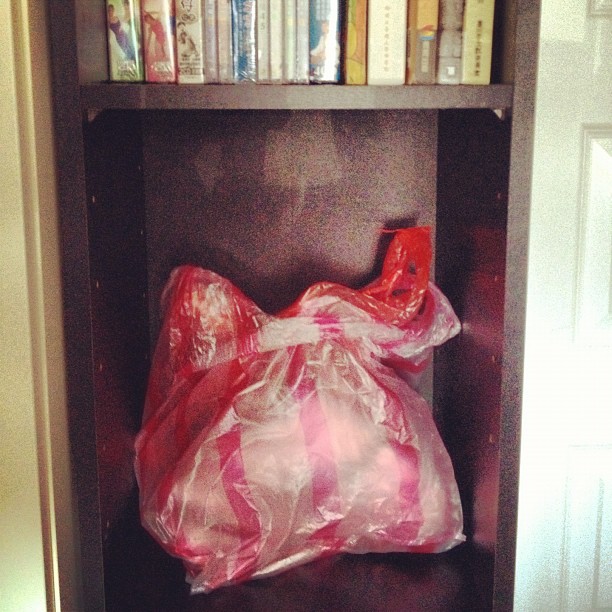
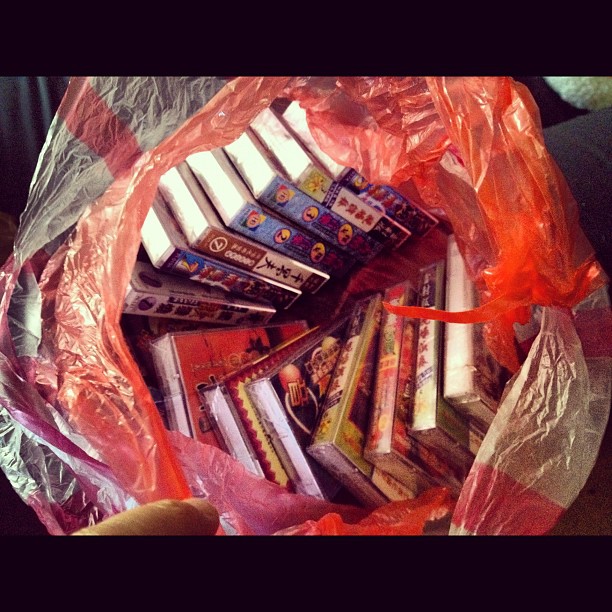
The plastic bags themselves remind me of the field encounters I had this summer. The plastic bags not only represent a kind of Taiwanese local street culture that is sometimes associated with the working-class; but they also provide a clue for my quest for the meaning of nakashi in contemporary Taiwan. Here how it all unfolds.
I spent a quite bit of time wandering in the Wuxing Day Market (吳興市場, a great photo series). This is partly because my dad’s dental office is located literally inside the day market that runs from daybreak until about noon. Day markets in Taiwan are a kind of street-based “traditional markets” (傳統市場) that are set up in an semi-ad-hoc manner. Day markets are where mobile produce and meat vendors set up their stands. These vendors transport their goods in vans and oftentimes in blue pick-up trucks from one location to another based on the day of the week. Butchers hang their meats; vegetables come in crates; poultry sometimes come as live animals. Occasionally you would find dried goods, cooked food, and other living essentials like socks, underwear, and leisurely goods like music and movies. The vendor stands usually have no refrigeration; but are generator-powered to run electricity for lighting and background music. Music and recorded sales pitches project from boomboxes and loudspeakers. The day market is a great example of the Chinese notion of renao (熱鬧), liveliness, hustling, or bustling.

Bargaining is a common practice at the day market. The social and economic structure of the day market is complex and it seems quite distinct from the rest of rationalized system in Taiwan that is either state-sanctioned or corporatized. A more visible counterpart to the day market is the night market, which appeals to young people and has become an emblematic symbol of Taiwan in the overseas communities. In contrast to convenience stores and super markets, both associated with the urban elites, the majority of the clientele of the day market are the economically underprivileged, notably lower-middle-class housewives and the elderly. I got a glimpse of the day market because of an incidental interaction I had with a music vendor.
On a sultry early afternoon, I wandered downed Wuxing Street as the vendors at the day market were packing up. I spotted a music stand. From an empty storefront, this vendor stand extended via a line of adjacent folding tables. What caught my eyes was a box of cassette tapes, a medium rather uncommon in contemporary Taipei. I exclaimed, internally and loudly while trying to maintain my coolness so as to not appear as a visitor, “These are the nakashi tapes that I’ve been looking for!” These tapes contain mostly instrumental tracks of popular songs from the repressed genre of Taiyuge, meaning “Taiwanese language songs.” These songs are sung in Taiwanese Hokkien dialect that originated in southern China. While a large part of this repertoire consisted of Taiwanese reinterpretation of Japanese enka songs, a subset of these songs came out of the 1930s recording industry during the Japanese Occupation era. While most of these tapes contain instrumental tracks, some of them are “greatest hits” compilations of full (vocals included) tracks of the same repertory.
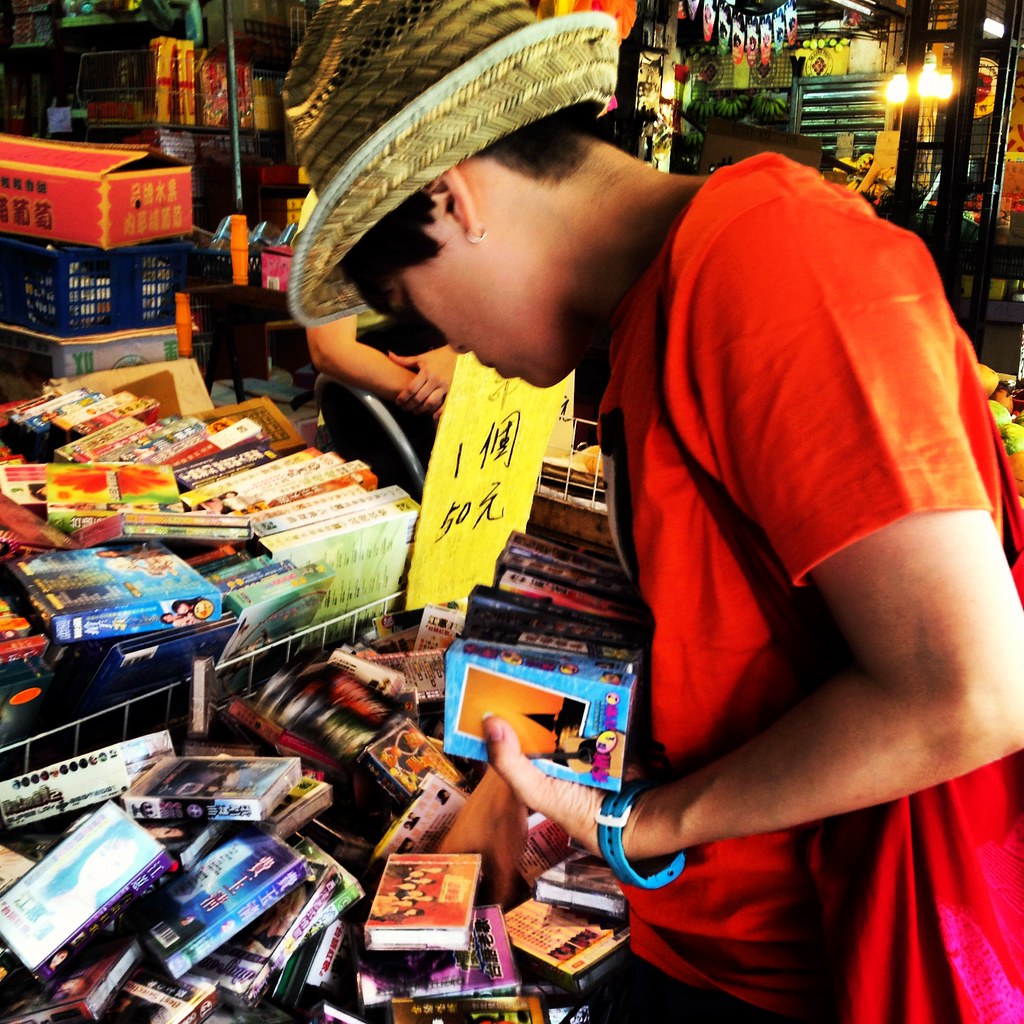
I was surprised to see that these tapes were not covered in dust. I asked the woman vendor, who appeared to be in her 40s, “Do people still listen to these tapes?”
“Of course! Taxi and truck drivers listen to these because many of the commercial vehicles are equipped with cassette decks still. And of course, baba and mama (“dads” and “moms”) listen to tapes because they haven’t switched over to CDs. But we sell everything and we have something for everyone here,” she explained.
“Oh, I didn’t know that! But that makes a lot of sense. I like these tapes because of the music.” I looked in the box and picked out 8 or so tapes.
“Yea, we carry a lot of things that are hard to find these days. Here, go ahead and pick out a couple more tapes. I’ll give you a discount. Buy ten get one free!”
I thanked her profusely and she put the tapes inside a pink-and-white-striped plastic bag. These bags are the generic plastic shopping bag in Taiwan. They are often used by market vendors probably because they are inexpensive and sturdy. I remember them from my grandparents’ grocery story inside the Nanmen Day Market (南門市場) near Chiang Kai-Shek Memorial.
I paid the lady and scurried away. It was 1:30pm in the afternoon. The pacific heat wave on a small island near the tropics was brutal. I had a plan to cool off inside Taipei 101, Taiwan’s architectural pride, also a symbol of its financial power. The subtropical heat and island humidity got to me. By the time I walked to the Starbucks inside the upscale, super-air-conditioned mall that’s attached to Taipei 101, my head was spinning. I sat down to work on a conference paper. Afterwards, I trotted over to the Eslite Bookstore, an elite mega book seller in Taiwan, seeking a relieve from the heat and got dinner. I eventually made it through the hottest time of day and got back to my dad’s apartment only to discover that my bag of tapes was missing.
I subsequently spent the next day tracing my steps through the day market and the upscale Xinyi district near Taipei 101 looking for my nakashi tapes. At the day market, I saw no traces of the music vendor. Their spot was occupied by a vegetable stand.
Hilarity ensued when I approached the staff members at Starbucks, Taipei 101, and Eslite to inquire about my lost nakashi tapes. The attendant that I talked to at Taipei 101 asked what kind of “shopping bag” my nakashi tapes were in. I told her that it was a just ordinary pink-and-white-striped kind. She seemed mystified that such an ordinary item would appear inside this fancy shopping mall. The contrast between a kind of underclass localism, associated with the ordinary plastic bag, and an acclaimed architectural symbol of transnational financial power, seemed ludicrous.
The sales representative at the Eslite Bookstore was similarly perplexed by my request to find cassette tapes, which seemed so out of her framework of a multilingual mega book and music store, with a massive online store, that carries titles ranging from imported arts magazines from the United Kingdom to Chinese-language academic books on prewar music in Taiwan. The ostensibly comprehensive music section inside the Eslite building didn’t have any music recordings that would fall into the genre of nakashi. There were, in fact, no analog cassettes in stock. Instead, I encountered was a giant glowing hipster-y display constructed out of cassette tapes. Hipsters in Taipei are apparently not vinyl- or cassette-crazy. [Not yet, at least.] Needless to say, I didn’t find my tapes that day; but I learned much about the physical and symbolic separation between these two worlds.
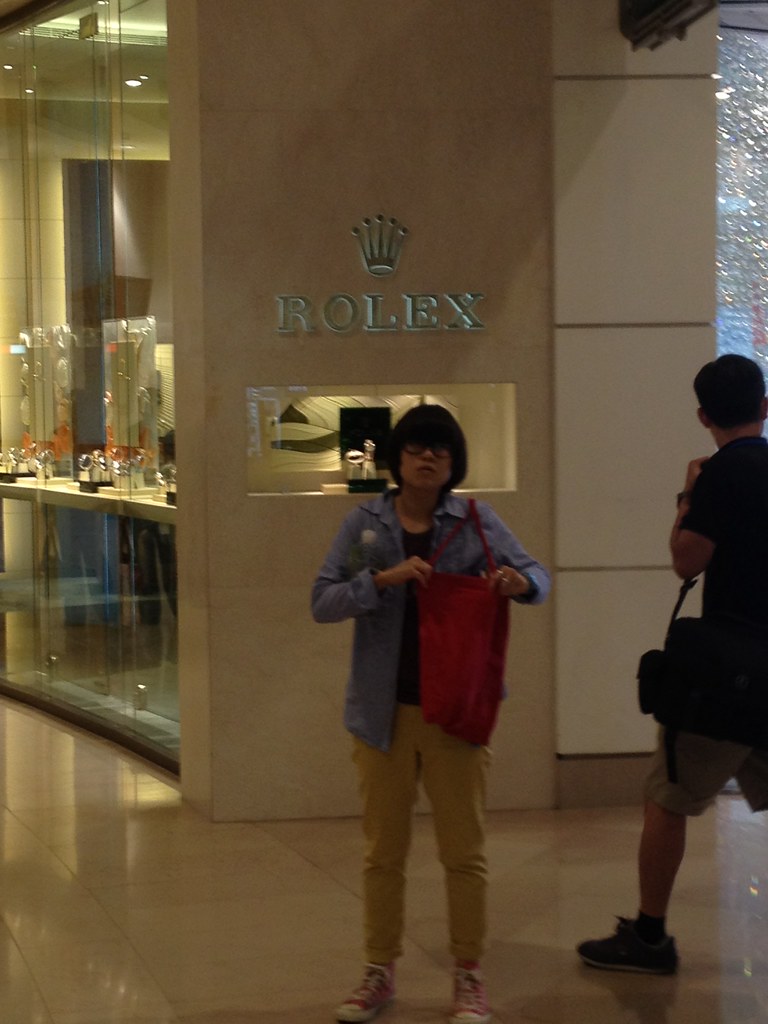
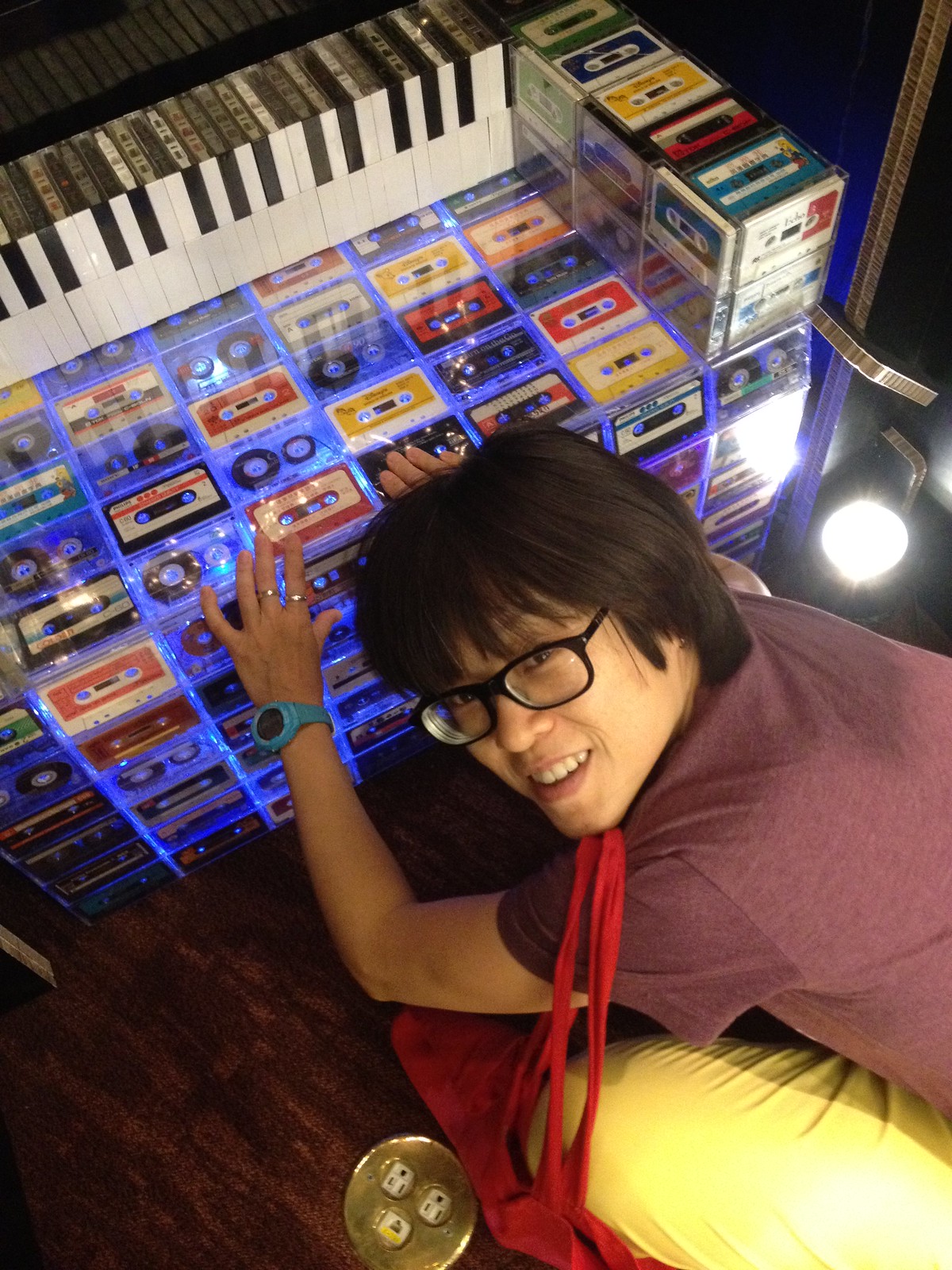
I had a faint memory of the music vendor’s fluid schedule – every Tuesday or Wednesday, or “sometimes every other week.” We went back to the day market the following week. The stand was there, as if it never moved. The tapes were still there, the same sales staff, one woman and a man, working diligently.
The woman said to me, “I was worried that you weren’t coming back. I saved your tapes, but left them in the van. Go ahead and pick out eleven tapes. Here, we do ethical business. We sold you some things, and now they belong to you. We will not scam you.” Rest assured, I found more tapes and got a bag more goodies (including nakashi instrumental CD sets that feature shamisen and instrumental music for square dancing).
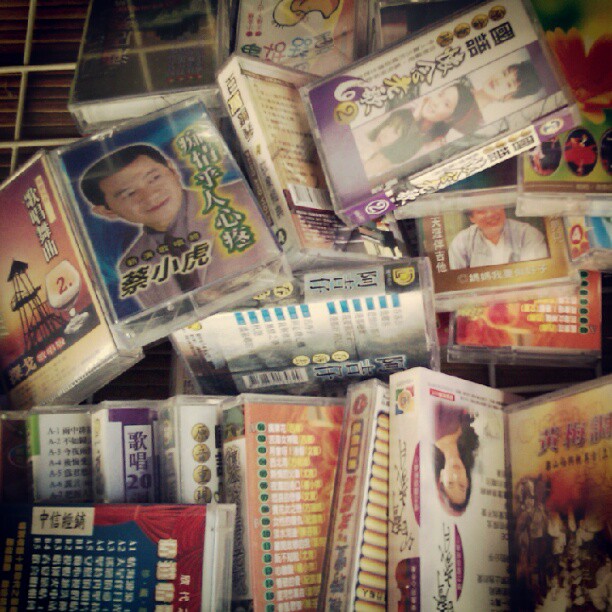
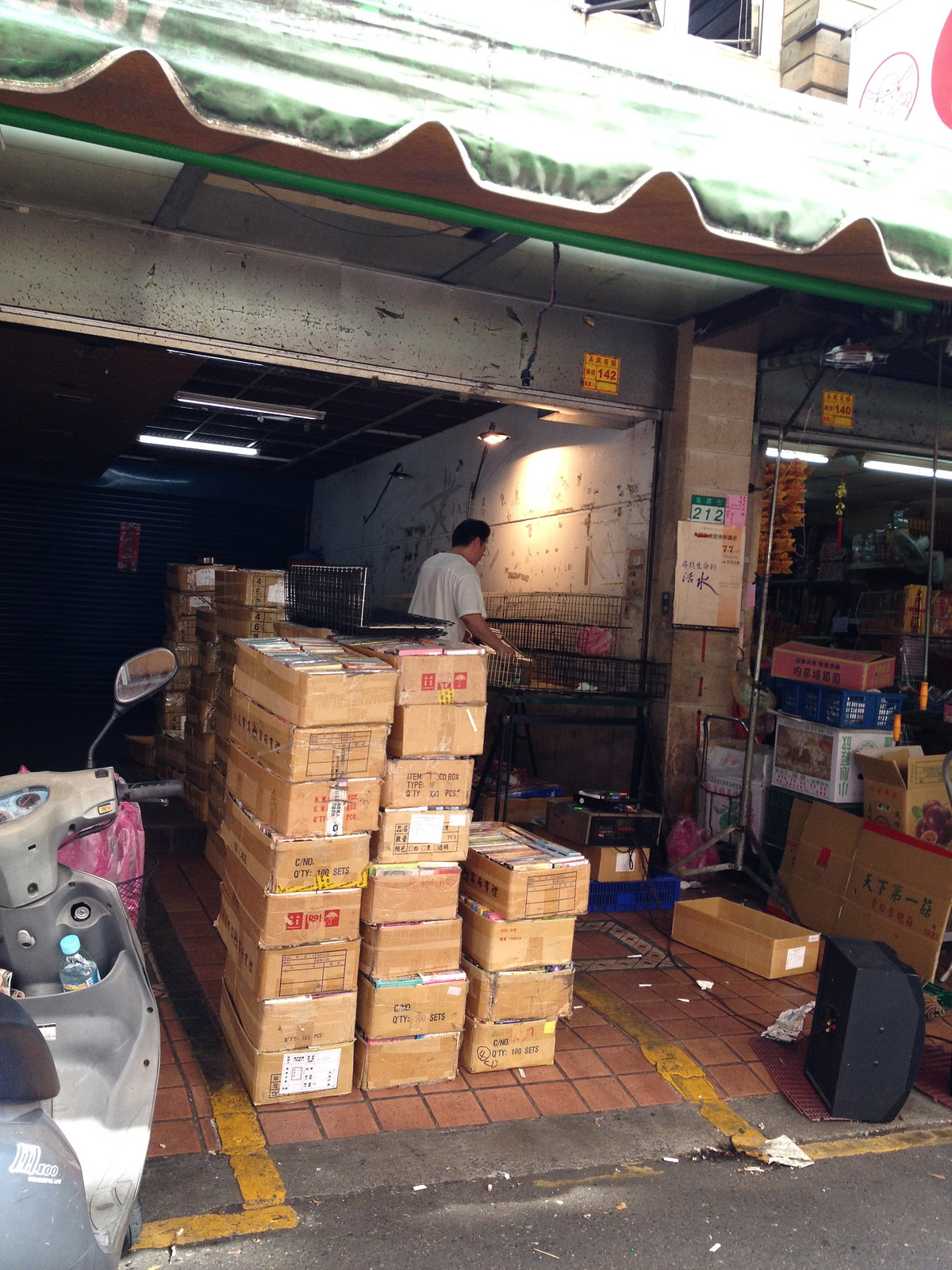
Now that I’m done speculating about the meaning of the plastic bags, I think I’m ready to listen to the tapes that are inside the bags. There is much to be unfolded about the Wuxing Day Market. There is a bit of nakashi magic — quiet but lively — happening in the area. An old-school music store run by a nakashi musician [that I blogged about from my last trip] is right down the street. Through acquiring and losing these tapes, I witnessed a social intimacy between this analog music-culture, the hustling and bustling and the fluid economy at the day market, and the dynamics of the elderly generation and the cab-and truck-driving working-class in Taiwan. I look forward to finally listening to these tapes. Perhaps it will help me unwind this cluster of meanings regarding place, music, and economy.


 bio
bio